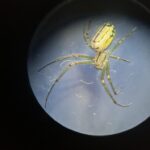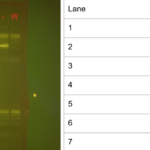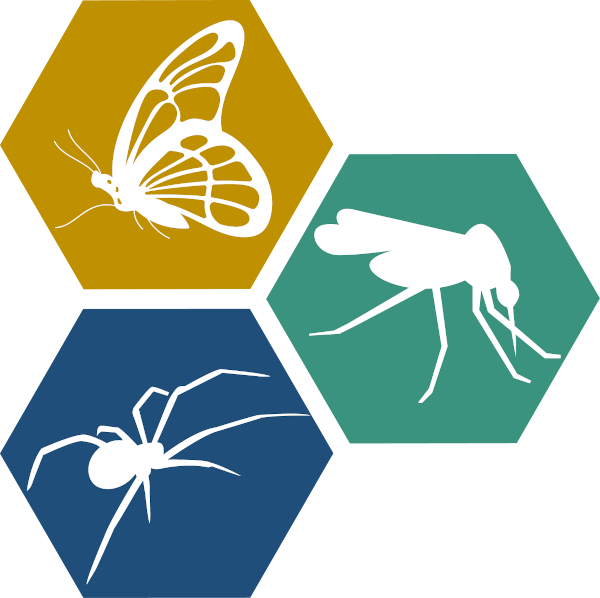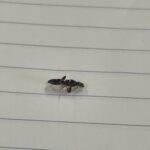Sample information |
|
| Picture |

|
|---|---|
| Location | |
| Collection date | 05/30/2023 |
| Captive / Cultivated? | Wild-caught |
| Group | Pingry School |
| Observations | Found spider sharing a web, which had been woven between the branch and main body of a fallen tree, with another spider of a different species (Neriene radiata). This spider is green with a silver, black, and yellow abdomen. Its cephalothorax had appeared slightly translucent. |
| Putative identification | Arthropoda Arachnida Araneae Tetragnathidae Leucauge Leucauge venusta |
Methods |
|
| Extraction kit | DNeasy (Qiagen) blood and tissue kit |
| DNA extraction location | Abdomen |
| Single or Duplex PCR | Single Reaction |
| Gel electrophoresis system | Standard electrophoresis system |
| Buffer | TAE |
| DNA stain | SYBR Safe |
| Gel images |

|
| Protocol notes | We accidentally used ladder instead of loading dye when we were preparing our samples, and as a result, our gel was a little hard to read. However, the ladder solution had loading dye in it, so the DNA still ran through the gel. We re-ran the whole process, but our new gel ended up having no results, not even in our controls, so we kept this gel. The sample extracted from the Leucauge venusta is in lane 2 (shown in the table). We prepped the samples and then ran them through a gel for about 15 minutes at 100 watts. The top half of the gel shows results for the C01 arthropod gene, and the bottom half shows results for the 16s Wolbachia gene. The sample in lane 2 had a band aligned with the band from the positive arthropod control, showing a positive result for the CO1 arthropod gene for the spider. The sample in lane 2 also had a band that lined up with the positive Wolbachia control, meaning the spider had the 16S Wolbachia gene in addition to the arthropod CO1 gene. |
Results |
|
| Wolbachia presence | Yes |
| Confidence level | High |
| Explanation of confidence level | I am highly confident, for when I entered my Wolbachia 16s gene sequence (381 nucleotides long) into the BLAST database, it returned a 100% match to other Wolbachia entries. Gel results also support this conclusion. |
| Wolbachia 16S sequence | Download FASTA
Download AB1
AGGTGTTGCATGGCTGTCGTCAGCTCGTGTCGTGAGATGTTGGGTTAAGTCCCGCAACGAGCGCAACCCTCATCCTTAGTTACCATCAGGTAATGCTGGGGACTTTAAGGAAACTGCCAGTGATAAACTGGAGGAAGGTGGGGATGATGTCAAGTCATCATGGCCCTTATGGAGTGGGCTACACACGTGCTACAATGGTGGCTACAATGGGCTGCAAAGTCGCGAGGCTAAGCTAATCCCTTAAAAGCCATCTCAGTTCGGATTGTACTCTGCAACTCGAGTGCATGAAGTTGGAATCGCTAGTAATCGTGGATCAGCACGCCACGGTGAATACGTTCTCGGGTCTTGTACACACTGCCCGTCACGCCATGGGAATTGGTT
BLAST at The Wolbachia Project BLAST at NCBI
|
| Arthropod COI sequence | Download FASTA
Download AB1
TGGTGCTTGAGCTTCATAGTAGGGACAGCTATAAGTGTGCTAATTCGGATTGAGTTACGTCAATCGGGAAGATTTTTAGGCAATGATCAATTGTATAATGTGATTGTAACATCTCATGCTTTTATTATAATTTTTTTTATAATTATACCTATTTTAATTGGGGGATTTGGAAATTGATTGGTTCCTTTAATATTATGGGCTCCTGATATGGCTTTTCCTCCCATAAATAATTTAAGTTTCTGACTATTACCTCCTTCACTCTTTTTATTATTTATTTCTTCAATGGTAGATATAGGAGTGGGGGCTGGGTGAACTGTATATCCTCCTTTAGCTTCTTTAAAAAGGCATTCTGGTAATTCTATGGATTTTGCTATTTTTTCTCTTCATTTAGCTGGGGCTTCTTCCATTATAGGGGCCATTAATTTTATTTCAACTATTTTTAATATACGGGTAAATGGAATAAAAATATAAAAATTTCCTTTATTTGTTTGATCTGTGTTAATTACAGCTGTTTTATTATTATTATCCCTCCCGGTTTTGGC
BLAST at The Wolbachia Project BLAST at NCBI
|
| Summary | The Leucauge venusta was found to be postive for Wolbachia. |
 European Paper Wasp
European Paper Wasp Woodworm Ant
Woodworm Ant